ANATOMY OF A CHAIR
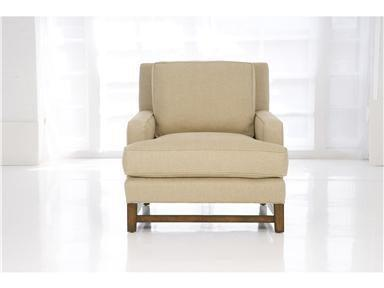
Our good friends at Kravet Furniture were kind enough to "undress" this chair and demonstrate, from scratch, the process that actully constitutes the creation of a Fine American Made, Upholstered Chair.
Meet the "Pelham".
Here is the quick outline of this fascinating process:
The manufacturing of this one single piece passes thru the qualified hands of many skilled craftspeople: The furniture designer, frame and pattern makers, internal material suppliers and fabric mills. Then products are labeled, displayed, and presented to the showroom personnel and sales staff. Inspired interior designers create their vision of their projects for colaboration with their clients, aesthetic decisions are finalized, pieces ordered, constructed and then off to the final destination, your home.
Once an order is placed, the process clicks into gear:
The Cutter: unrolls the yards of fabric, lines-up the pattern and cuts the material The Sewer: Stiches the fabric into shape, with welt if specified The Trimmer: Puts the fabric onto the chair The Inspector: Checks that all seams are straight and the fabric lines-up as intended
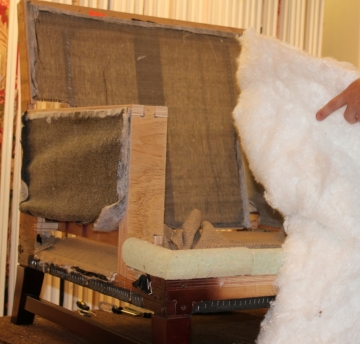
The Frame
The foundation of each piece of furniture is it's "frame" which is a hybrid product: a mix of both hardwoods and laminates, made specifically for the furniture industry. This combination of materials insures a strong frame that is guaranteed by Kravet to last the lifetime of the original owner. The legs are maple, which accepts the stain color of choice, evenly.
Each frame is glued, screwed and double doweled.
Not skimping on the ingredients is the mark of a quality product.
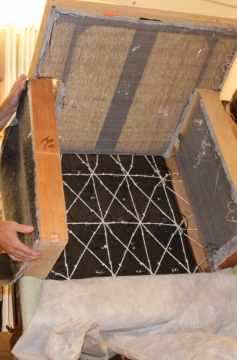
8-Way Hand Tied
Is the process that separates a fine piece of furniture from the mass produced variety.
It refers to the actual knotting of the bottom springs in 8 places front- to-back and side-to-side.
(see the white cording above).
This old world craftsmanship insures the chair will be stable for it's life and feel great to sit in for future decades. As opposed to a mass produced type that has a drop in mechanism of springs that feels hard and uncomfortable.
The black burlap on the bottom and hog-ring clips, hold the hand-tied springs in place. There are metal bands at the bottom of the chair that you will never see or feel when the chair is complete, which also adds a layer to the stability of the seat.
Also notice the corner blocks, the small square on the front of the arms.
They keep the wooden arms from loosening up and shifting from use.
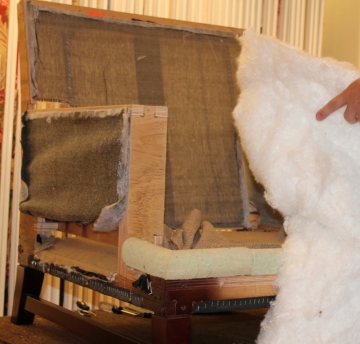
More layers, More comfort
With the polypropylene webbing in place, lots of layers of padding are added. The goal in layering the foam is to never ever feel the wood frame. Cushioning is applied not only on top of the foundation and hand-tied springs, but also on the sides and back. These are areas where you wouldn't expect that level of softness or attention to detail, but are the standard here. If that weren't enough, at least 3 extra layers of softness are applied on top of the front edge of wood, to add comfort to the back of your legs when seated and to extend the life of the cushion.
This material on the bottom of the inside of the chair is called "decking'. A sign of fine furniture is a self-decking meaning the fabric under the seat cushion which is attached to the chair, matches the fabric of the char. This area might only been seen when the cushion is removed for cleaning, but having it covered in matching fabric as opposed to a muslin material, is certainly a sign of a quality product. When leather cushions are used, breather panels must be used here, so the cushion doesn't slide off the chair and allows the leather to 'breathe".
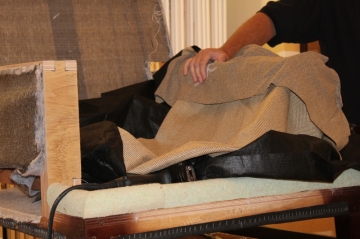
See the cushioning of poly-foam covering the wood arms and the templated fabric being secured on top.
Fabric
Aside from being the part I love to choose most, the process of its installation was quite fascinating. The fabric is sewn according to a pattern in the workroom and then, in a shaped sewn piece, secured to the frame of the chair. One artisan applies all the material to one piece of furniture. That insures an even look throughout the creation of each piece. It's these cut-to-order pieces that have the welt (round trim along the edges), applied, if desired. Welt's are one of those decisions that designers/client's have to specify when ordering the chair. Sometimes we prefer a "self-welt" made out of the same material as the body of the chair or sometimes a contrast welt. The contrast welt add a specific design element and if preferred requires an additional choice of 2 yards of a contrasting fabric. When welting is applied correctly, it should be firm, in a straight line and stand-up taught. I don't know how I thought welt was applied, but this method was a surprise to me!
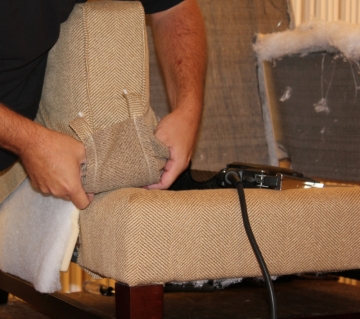
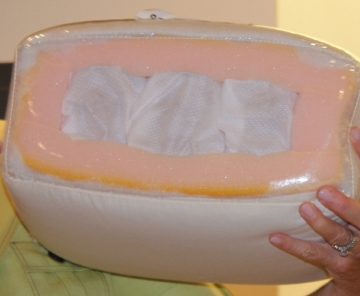
Cushions
It's with great experience that these cushions are manufactured. The spring coils inside the cushion are just that: a series of springs that are locked together and surrounded with foam. You would never detect that there are springs inside the cushion but if there weren't present, you would know. It's the same principal inside a mattress. This type of composition maintains it's memory much better than an all foam version, that could lose it's shape quickly. There are different types of down/foam combinations and if you are allergic options.
*note the plastic wrap is to keep the cushion clean, for presentation purposes
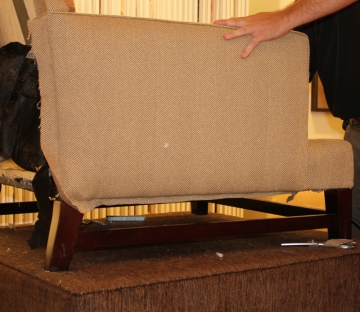
Starting to look recognizably like a chair, after 2 hours. This whole presentation ran 3+ hours which included one of Kravet's not-to-be-missed lunches (loved the California Slaw and oversized freshly baked cookies!)
--------------------
A quick word about what makes the manufacturing of this chair "Green."
-Each chair is made when ordered, thus the 8 week lead time. Long gone are the days that the frames are pre-made and stacked to the factory ceiling, waiting for an order. This also means the ease of cusomization in size and depth, is an everyday request.
-The bottom springs of the chair are made from recycled steel.
-The scraps of the foam and inside webbing inside that gets trimmed to fit the frame, are all collected and returned to their manufacturer for re-shaping into new full sheets to be used on other pieces. These left overs don't end up in a landfill.
![]()
We sincerely thank the generous,talented and dedicated team at Kravet. Particularly Susan and Steve for this presentation, whose masterful insight has changed the way this designer sees and educates clients and readers, as to the inherent value in fine furnishings.
By the way, You might be wondering what the price of this bespoke chair, in a choice of 50,000 fabrics costs? It varies based on the fabric selection but it's comparable to price as you would pay from a mass produced piece from a catalogue, that was made oversees, comes in just a few colors, might be delivered in a couple days but ends up on the curb in a couple years.
I hope you realize that this is just the anatomy of one chair. To see Kravet's vast selection of hundreds of upholstered chairs, sofa, sectionals and fabrics, click here. Since these products are only available thru the trade, we'd be happy to answer any questions.
Value and integrity is recognizable indeed. You're invited to do a sit test!
 September 30, 2010 in
September 30, 2010 in  Furniture
Furniture  Chairs,
Chairs,  Custom Furniture,
Custom Furniture,  Kravet
Kravet 



























Reader Comments